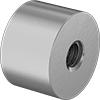Filter by
Thread Size
Material
Thread Pitch
Rail Height
Spring Type
Mount Type
T-Slotted Framing Component
Export Control Classification Number (ECCN)
DFARS Specialty Metals
Finish
Wire Diameter
Compressed Length @ Maximum Load
Height
Building and Machinery Hardware
Power Transmission
Fastening and Joining
Measuring and Inspecting
Fabricating and Machining
Material Handling















































































































